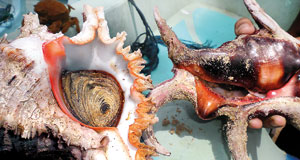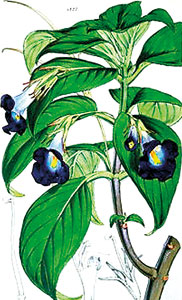A beautiful veil-tail Cherry Barb is on sale at Aquarama 2011 held in Singapore recently while a reputed international beauty-care company openly advertises Wewiya as the answer for wrinkles.
How is it that the Cherry Barb (Puntius titteya) endemic to Sri Lanka is being sold at Asia’s largest international trade and consumer event for ornamental and aquatic fish and Wewiya (Hortonia floribunda) once again endemic to Sri Lanka comes back to the country packed as a cream to slow down the development of fatty tissue?
Different forms of illegal wildlife trafficking are taking place, the Sunday Times understands, with many conservationists pointing out that if firm action is not taken, the consequences for Sri Lanka would be devastating.
Shellfish, sea horses, fresh water fish, tarantulas, lizards and plants, are all being spirited out of the country, it is learnt, being the “target” of illegal trade.
 |
| Spider conch and Murex, both being caught off Kalpitiya and sold within Sri Lanka.
Pic by Sewwandi Jayakody |
While the Cherry Barb and Wewiya examples are highlighted by the Deputy Director of Customs, Samantha Gunasekara of the Biodiversity Protection Unit, environmental lawyer Jagath Gunawardene focuses on the internet or the worldwide web as the latest “market ground” for illegally trafficked wildlife.
Stressing that the second biggest illegal trade across the globe is the wildlife trade, with narcotics being the first and firearms being the third, Mr. Gunasekara explains that illegal wildlife trade can involve animals or plants, their parts, their products or their derivatives.
“It is both contrary to national and international law and the impact is not only environmental but also economic and social.”
The wildlife trade becomes illegal if the material is illegally obtained and illegally exported from Sri Lanka, says Mr. Gunawardene. Such illegal trade takes on a dangerous dimension because 25% of all species, both animals and plants, in Sri Lanka are endemic. The endemicity of certain classes of animals is proportionately higher than 25% and of a very few categories like birds less than 25%.
Pointing out that all five species of tarantulas (divi makuluwa) found in the country are endemic as are land crabs, he says that even though certain other species may not be endemic, their subspecies or variations could be.
Illegal wildlife trafficking could lead to over-collection, over-exploitation and uncontrolled collection of both animals and plants. Therefore, rare species could become extinct quickly and common species could also become extinct gradually, according to Mr. Gunasekara.
Environmentally, in the wake of illegal wildlife trafficking would come a genetic drift, loss of endemism and loss of eco-balance, he explains, adding that even loopholes in the laws governing legal trade could be used to feed the illegal trade.
For such illegal trade, the best, the most colourful specimens would be harvested, says Mr. Gunasekara pinpointing the example of the pretty, brightly-coloured Bulath Hapaya or Black Ruby Barb (Puntius nigrofasciatus) being exploited. Unfortunately, they would also include the best gene pool, resulting in a genetic drift and ultimate biodiversity degradation.
The veil-tail Cherry Barb at Aquarama was another classic example of loss of endemism of our species, he says, while we would also lose out on our eco-balance if keystone species are exploited and food chains and food webs affected.
Keystone species losses could come in the form of big animals such as elephants or small animals such as fish, especially coral fish. We will get to know only much later and then it will be too late, says Mr. Gunasekara, adding that if the doctor fish which cleans up parasites are exploited an indirect effect would be harm to the health of the coral reefs.
Dealing with the economic aspects, he says that although the Cherry Barb is sold in Sri Lanka for Rs. 7 or 8, in the United Kingdom it is as high as £20 (Rs. 4,000). “We are not only losing out on the environment but also losing big money.” Urging a cost-benefit analysis even under the legal trade, he says that then it would ensure sustainable exports.
Regrettably, the Sunday Times learns, 99% of fresh water fish for export are all collected from the wild; except for one all marine organisms are collected from the wild and more than 500 species of coral fish are also collected from the wild.
 |
| Chirita Walkeri |
Star fish, sea slugs, sea fans, sea urchins, shrimp, sponges, sea anemone are big exports on permits but through the legal trade loopholes exploitation takes place along with gene piracy, it is understood.
Ornamental and medicinal plants have also fallen victim, with patents being taken out not by Sri Lanka but in countries such as America, Denmark, Germany and Japan, says Mr. Gunasekara, giving some examples such as Binara, Gal Demata, Kothala Himbutu, Venivel Geta, Gotu Kola and Mas Bedda
Referring to the thriving internet sales of Sri Lankan wildlife, environmental lawyer Jagath Gunawardene asks the relevant question how endemic animals and plants are up for grabs in other countries.
Specific are the examples spotlighted by him. In April, a Japanese firm was selling Hump Nosed Lizards (Lyriocephalus scutatus) while a Russian firm was touting five species of lizards including the Kangaroo Lizard (Otocryptis nigrilissma) all endemic to Sri Lanka. The Kangaroo Lizard is new to science and was described only in the late 1990s.
As catching and identifying these reptiles require scientific knowledge, it is obvious that someone who possesses a good knowledge of the subject is part of the racket, says Mr. Gunawardene.
Moving on to plants, he says that Chirita Mooni and Chirita Walkeri both endemic to this country are being advertised abroad, the first in the past four years and the other since September, last year, by a US-based firm called Kurtz Greenhouses. The Yellow Dragon Plant (Yellow Balsam or Impatiens repens) has been up for sale in the US for four years.
All these plants are protected under Section 42 of the Fauna and Flora Protection Ordinance (FFPO) and it is a mystery how smuggling takes place. If the plants are non-flowering, Customs officials may not be able to identify them, says Mr. Gunawardene, adding that star tortoises, Russell’s Vipers and Cobras, although not endemic, are also on the net for sale, with the bold claim that they are from Sri Lanka.
Meanwhile, three weeks ago the Indian authorities apprehended some smugglers who had sent sea horses as contraband from India to Sri Lanka to be exported to the Far East including Hong Kong, a hub for illegal wildlife trading, he says.
Mr. Gunawardene who scrupulously keeps track of the “happenings” in the wildlife scene goes back to December 2008, when the Chilaw Police arrested sea horse smugglers. Tracing the common North Western Province smuggling route, he explains that as the Indian law does not permit the export of sea horses, they are smuggled to Sri Lanka and then to Hong Kong.
Focusing on the ambiguity of the Sri Lankan laws, he says although no indigenous plants or animals can be exported under the FFPO, fish (which includes all aquatic animals) may be exported under the Fisheries and Aquatic Resources Act. This Act states it is complementary to the FFPO which means in cases where this Act is silent, provisions of the FFPO should play the deciding role. However, over the years, the Department of Fisheries and Aquatic Resources has been giving contrary opinions using this Act, which has caused confusion in many quarters. “This is the loophole through which illegal trade takes place.”
While limited trade of sea horses is allowed under the Convention on International Trade on Endangered Species (CITES) and a permit has to be sought from the Department of Wildlife Conservation, for the export of such species, exploitation may occur due to the stance adopted by the Department of Fisheries and Aquatic Resources, he explains.
There is also confusion, leading to the surreptitious trade in “look-alike” animals, the Sunday Times learns, a case in point being the Pipe Fish from the same family as the sea horse. The heads of the Pipe Fish and sea horse are similar and if the body is crushed it would be difficult to differentiate between them. There is no demand for Pipe Fish but suddenly we may find that they are being exported in large numbers, warns Mr. Gunawardene.
Regarding illegal trading within Sri Lanka itself, Mr. Gunawardene says there is a thriving business in shells brought from Mannar, Kalpitiya and Jaffna in other parts of the country.
Giving an early warning, he says that as conches are exported legally, there may be the likelihood of other types being smuggled out among them.
The question being pondered by conservationists is why the authorities are not investigating these issues, especially sales on the internet of Sri Lanka’s endemic plants and animals. Why, looms large and unanswered. |



